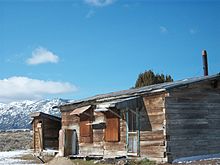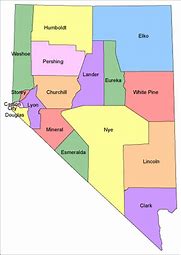|
White
Pine County
Trails to
the Past of Nevada is accepting any donations of
genealogy materials that you may have such as marriage
announcements, news articles, old obituaries, births,
(you do not need the birth certificate) just the
information, and biographies. If you have any of
these items please contact me Marie Miller the Nevada State
Administrator.
White Pine County
was established by European Americans in 1869 from
Lander County and named after the heavy growth of Limber
Pine trees in the area, which were then called white
pine. Hamilton was the first county seat from 1869 to
1887, when it was replaced after a fire by Ely.
 A building in Cherry
Creek that belongs to the Rude Family from California.
This old cabin built out of railroad ties was the assay
office during the mining operations and is now used as a
hunting cabin. A building in Cherry
Creek that belongs to the Rude Family from California.
This old cabin built out of railroad ties was the assay
office during the mining operations and is now used as a
hunting cabin.
In the early 1860s, the
area around Cherry Creek was discovered to have
substantial mineral deposits of gold and silver. The
community was founded on September 21, 1872 when two
prospectors from nearby Egan Canyon located the "Tea
Cup" claims, rich deposits of silver and gold ore. By
spring of 1873, the community had an estimated
population of 400
Boom and
bust.
In 1873,
Cherry Creek included a livery stable, a blacksmith
shop, a large hotel, several boarding houses,
restaurants, and more than twenty saloons. Cherry Creek
continued to grow in 1873. Wells Fargo opened a station
in Cherry Creek, and the Cherry Creek post office also
opened for business in 1873. However, in early 1874,
most of the original mineral claims in the area began to
play out. As a result, Cherry Creek's economy and
population began a decline, and by 1875, although
limited production continued, most of the local mills
and mines had closed. For 1875-1880, Cherry Creek
remained a small mining community, sustaining a much
smaller population and workforce than it had during the
prosperous years of 1872-1874.
Cherry Creek's
economy and population rapidly expanded once more in
1880, when additional deposits of gold and silver were
discovered. Over the next two years, Cherry Creek
experienced its biggest boom. By the end of 1881, a
single one of the larger mines locally employed over 200
men. Cherry Creek became the largest voting precinct in
White Pine County. By 1882, the community was at its
peak, with both its economy and population exceeding
their previous highs during the boom of 1873-1874.
During 1882, the community was estimated to have a
population of 7,800, of which 6,000 were estimated to be
transient mine workers. During this time, 28 saloons
were located in Cherry Creek. There were also a
substantial variety of stores and local businesses, most
catering to local mine workers. A stagecoach route to
Toano, in Elko County, was created and in service during
this time. By the end of 1882, one local mine had
produced more than one million dollars in gold bullion,
a huge amount for the time. The boom of 1880-1883 was
the most economically prosperous period in Cherry
Creek's history.
In 1883, a
financial crash devastated the local economy. Many mines
closed, and the community entered a rapid decline. In
1888, a fire destroyed a substantial portion of the
town's business district. By the census of 1890, the
population had fallen to 350. Cherry Creek experienced
large, damaging fires in 1901 and 1904. Many of the
original buildings in the community were burnt down and
had to be rebuilt. In 1905, Cherry Creek's economy
experienced a modest revival when a number of local
mines reopened. Cherry Creek remained the home of
several hundred people, and the base of substantial
mining activity, until the late 1940s.
|
|
City
Ely
(county seat)
Census-designated
places
Baker
Lund
McGill
Preston
Ruth
Other
unincorporated places
Cherry
Creek
Crosstimbers
East Ely
Lages
Station
Majors
Place
Riepetown
Schellbourne
Strawberry |

|
Adjacent
counties
Elko
County - north
Tooele
County, Utah - northeast
Juab County, Utah -
east
Millard County, Utah - southeast
Lincoln
County - south
Nye County - southwest
Eureka
County - west
The information on Trails to
the Past © Copyright
may be used in personal family history research, with
source citation. The pages in entirety may not be
duplicated for publication in any fashion without the
permission of the owner. Commercial use of any material
on this site is not permitted. Please respect the
wishes of those who have contributed their time and
efforts to make this free site possible.~Thank you!
|


